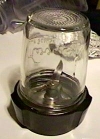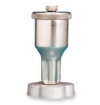Table of Contents
Presentation
Liquid inoculation is a very effective method, applicable to most fungi. The inoculation is clean, fast, as is the recovery. This method can transform a Petri dish into over 50 L of mycelium. On a small scale, you can even use only first generation cultures (G1), limiting handling, vegetative growth delay, and the risks of contamination associated. It is much more efficient than the traditional grain-to-grain inoculation. However, it require a rigourously clean environment (laminar flow hood). The downside is that a single contaminant in the liquid is equivalent to a batch of contamined pots.
Equipement
- Autoclave
- Scale
- Petri
- Scalpel
- Propane torch
- Magnetic stirrer
- Stir bar
- Modified erlenmeyer flask 1000ml
- Blender (3 options);
- Eberbach™ stainless blender with a Waring™ base: Excellent, durable, but expensive.
- Blender base mounted on a mason jar: Economic, but may melt during autoclaving.
- Pieces of broken glass in a mason jar: Free, but questionable efficacy, risk of injury…
Preparation
Ingredients
- Agar
- Malt extract
- End-substrate (straw, sawdust…)
- Dry yeast
- Gypsum
Procedure
First you must inoculate 2-3 Petri dishes. When the mycelium reaches 1 cm from the edge, select the one that looks the healthier and discard the others. This is the only one you will use. Then prepare your solution :
[For each Petri],1)
- Add 200 ml of water in the mixer.
- In the erlenmeyer flask, add the magnetic bar, 600ml of water, 24 g of malt extract, 2.4 g of sawdust or straw, 1.2 g of yeast and 0.6 g of gypsum (optional).
- Once all the ingredients are dissolved, firmly tighten the cap on the flask and place it in the sterilizer along with the mixer. Cover with a towel, and sterilize at 15 psi for 45 minutes.
- Turn off the heat and wait until the pressure reaches 1 psi. Release the remaining pressure in front of the hood, open the sterilizer and let cool both containers directly in front of the HEPA filter. A towel placed before the sterilization can act as a shield, in case that you have to move the inner container of the sterilizer to the laminar flow hood.
(See the Recipes calculator)
Inoculum preparation
The mycelium of the selected Petri dish is first pulverized in small clusters of cells (mixer). The solution of water — mycelium is then incorporated into a nutrient solution (Erlenmeyer). The fermentation will allow them to begin their growth and restructure into thousands of strong colonies. When poured in the substrate, each of these colonies will act as a point of inoculation. This liquid must be used quickly (48-96 h), otherwise the colonies will merge together and the recovery will be slowed.
To allow the mycelium to breathe during fermentation and prevent sedimentation, the solution must be placed on a magnetic stirrer at 200 rpm, in a container with an air filter. You may increase the speed slightly, but a slow stirring allows the cells to merge, thus allowing a better recovery on the next substrate. If the agitation is too fast, the mycelium can not restructure.
Another method is to pour the solution of water and pulverized mycelium directly on the substrate, without fermentation. This is a shortcut to the fermentation, but its use is limited to small volumes.
- With the utmost care, using a torch-sterilized scalpel, cut 4 pieces of mycelium in the Petri dish. Try not to touch the 1 cm uncolonized edge of agar, because is it likely to contain invisible contaminants. You must draw a circle around the margin of the mycelium, and then make a cross to separate the circle into 4 quadrants.
- Place each of these quadrants in the blender and replace the cover. Turn the mixer for 3 seconds, let stand for 5 seconds, 3 times. The mycelium is now well pulverized. In front the hood, still, pour the liquid into the nutrient solution. Close the lid and place the flask on the magnetic plate.
- Incubate during 2 to 4 days. The pulverized mycelium will have just enough time to recover and transform itself into thousands of individual colonies, representing as many points of inoculation. It is important not to incubate for too long, because colonies will merge and lose their vigor and much of their contact surface.
Inoculation & Incubation
- It's time to use the inoculum. By groups of four, unscrew the lids (without lifting them) and place the pots in front of the laminar flow hood.
- Sit in front of the hood and remove the cap from the flask. One at once, open a jar of sterilized substrate and pour about 15 to 25 ml into it. Replace the inoculum near the HEPA filter (without it's lid), close the jar and shake it gently. Try avoiding contact between the grain the lid.
- Store the containers away from light. After about 7 days at 24 º C, or when the colonization reaches 50%, hit the pots one by one, against a car tire, precleaned and supported by a bracket.
- 11-14 days later, the jars should be fully colonized. You can strike them again against the tire to break the mycelium evenly. It is then ready to inoculate a new substrate or directly for flowering.
If the pots were bumped, the glass might be weakened in one or more points. These cracks may be unnoticed, but they will certainly reveal once they are gonna be striken against the tire. Shards of glass may cause serious injuries, use proper safety equipment (goggles, butcher gloves, etc.).
Flask adaptation for liquid culture
The mycelium needs to breathe. In order to facilitate the entry of oxygen and to release the C02, the solution must be constantly agitated during the incubation period. In the literature, it is suggested to cover the opening of the flask with non-absorbent cotton covered with aluminum foil. This method works, but makes handling harder. In addition, it is often necessary to replace the cotton and the aluminum foil. On a small scale, it is more convenient to use an polymethylpentene (PMP) Erlenmeyer with a modified lid.
To do this, use a torch-heated nail head to pierce the lid of an erlenmeyer flask. Then cut one micron filter so its diameter will fit snugly beneath the surface of the lid (5 cm). For a low cost, you get a durable erlenmeyer flask perfectly suited to liquid culture. Before the sterilization, the cap can be cleaned, if necessary, by soaking a few minutes in a solution of 5% bleach. It is not necessary to separate the filter, because the PMP is resistant to sodium hypochlorite. With a spare lid or an aluminum foil, you can still use the same flask to sterilize the agar.














